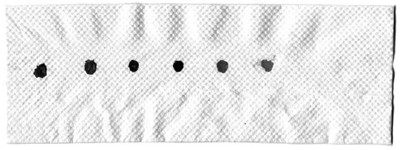Activity Unmix It Up
Ages 8 and older.
Have you ever mixed different colors together to make a new color?
Chromatography (a technique for separating complex mixtures) can be used to
separate colors that have been combined to make a single color. In this
activity, you will separate the colors in marker ink.
You Will Need
- white paper towel
- washable or water-based colored markers (two or more brands; pretested,
if possible, to make sure the ink will separate in some of the inks)
- water
- eye dropper or pipette
- newspaper or plastic (to absorb excess water)
What to Do
- Cover your work area with newspaper to keep the area dry.
- Make a large dot on the paper towel with one of the markers. Keep the marker
on the towel for several seconds to make sure your dot has a lot of ink.
- Repeat on the same paper towel with different-colored markers (same brand)
until you have 5 to 10 dots in a line on the paper towel (see picture below).

- Add drops of water to the towel near, but not on, the line of the dots. Add
one drop at a time and give the water time to slowly spread through the towel.
Do not add too much water.
- Observe what happens to your dots after 10 minutes. Notice that different
colors form when different inks run into one another.
- What colors came out of different inks?
- How many inks separated into different colors? Which ones?
- Why do you think some colors did not separate out?
- Which ink had the most colors?
- How do you know some of the marker inks were made from more than one
color of dye?
- Which marker color surprised you the most in terms of the number of dyes
used to make it?
- What did you learn about separating mixtures?
Extensions: Make a design with dots of ink clustered around the middle
of the paper towel. Then add water to the middle of the design and watch what
happens. Try different brands of markers. Compare to see if all brands use the
same color combinations and which produces the most combinations.
Learning More
Chemistry for Every Kid: 101 Easy Experiments that Really Work
by Janice Pratt VanCleave. Wiley, 1989.
Includes chemistry experiments for children in grades 3-8.
Janice VanCleave's 201 Awesome, Magical, Bizarre, & Incredible
Experiments
by Janice Pratt VanCleave. Wiley, 1994.
Includes chemistry, biology, earth science, astronomy, and physics activities
to be carried out with parents, guardians, or teachers.
American Library Association Great Web Sites for Kids: Chemistry &
Physics
www.ala.org/gwstemplate.cfm?section=greatwebsites&template=
/cfapps/gw/displaysection.cfm&sec=29
Includes chemistry links for ages pre-K through adult.

